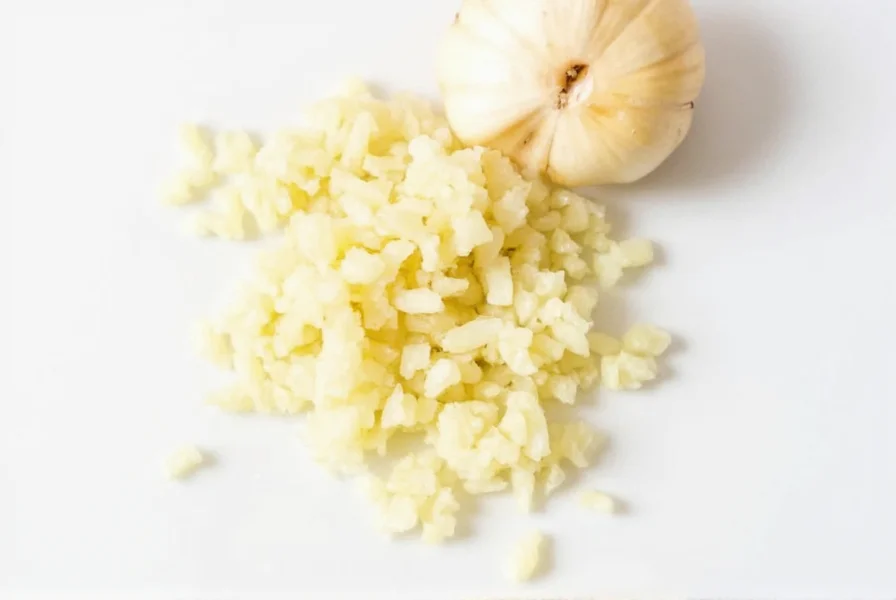Understanding garlic measurements is essential for achieving perfect flavor balance in your cooking. While the 1½ teaspoon standard works for most recipes, several factors can affect this conversion that every home cook should know.
Garlic Clove to Minced Conversion Chart
| Garlic Size | Whole Clove Weight | Minced Volume | Equivalent in Teaspoons |
|---|---|---|---|
| Small | 3-4 grams | 1 teaspoon | 1 tsp |
| Medium (standard) | 5-7 grams | 1½ teaspoons | 1½ tsp |
| Large | 8-10 grams | 2½-3 teaspoons | 2½-3 tsp |
| Jumbo | 11+ grams | 3½-4 teaspoons | 3½-4 tsp |
Factors Affecting Minced Garlic Measurements
The precise how many teaspoons minced garlic per clove conversion depends on several variables that impact your cooking results:
Clove Size Variability
Garlic cloves vary significantly in size depending on the variety and growing conditions. A single head of garlic typically contains cloves ranging from small inner pieces to large outer ones. When a recipe calls for "1 clove minced," it generally assumes a medium-sized clove.
Minced vs. Pressed Garlic
How you prepare the garlic affects volume:
- Hand-minced: Yields about 1½ tsp per medium clove with some air space between pieces
- Garlic press: Produces more compact minced garlic, yielding closer to 1 tsp per clove
- Microplaned: Creates the most compact form, yielding approximately ¾ tsp per clove
Moisture Content Differences
Freshness impacts volume measurements. Newly harvested garlic contains more moisture and yields slightly more minced volume than older, drier garlic. For the most accurate garlic clove to minced conversion, use firm, plump cloves without wrinkles.
Practical Measurement Tips for Cooking
When working with recipes that specify "minced garlic" without providing volume measurements, these techniques ensure consistent results:
Without Measuring Tools
If you don't have measuring spoons while cooking, use these visual references for how to measure minced garlic accurately:
- One medium clove minced = size of a quarter coin
- Three cloves minced = size of a ping pong ball
- Six cloves minced = size of a golf ball
Substituting Pre-Minced Garlic
When using jarred minced garlic instead of fresh, remember that commercial products often contain preservatives that affect potency. For accurate substitute fresh garlic for minced garlic conversions:
- 1 fresh medium clove = 1½ tsp fresh minced
- 1 fresh medium clove = 1 tsp jarred minced (due to preservatives reducing potency)
Freezing Minced Garlic for Future Use
To preserve excess minced garlic, freeze in ice cube trays with a little olive oil. One frozen cube typically contains the equivalent of 2-3 cloves minced. This method maintains flavor better than pre-minced jarred alternatives and provides consistent measurements for future recipes requiring precise garlic clove weight to volume conversion.

Why Precise Garlic Measurements Matter
Garlic's flavor compounds are potent and volatile. Too little won't provide the desired aromatic base, while too much can overpower a dish. Understanding the exact minced garlic measurement equivalents helps you achieve consistent results, especially in delicate sauces, dressings, and marinades where garlic plays a supporting rather than dominant role.
Professional chefs often weigh garlic for critical recipes. For precision cooking, note that one medium garlic clove weighs approximately 5-7 grams and yields 3-4 grams of minced garlic after removing the papery skin.
Frequently Asked Questions
How much jarred minced garlic equals one fresh clove?
One teaspoon of jarred minced garlic equals approximately one medium fresh garlic clove. Jarred garlic typically contains preservatives that reduce its potency by about 25-30% compared to freshly minced garlic, which is why you need slightly more volume to achieve equivalent flavor.
Does roasting garlic change the minced measurement?
Yes, roasting garlic significantly changes the volume. One roasted medium garlic clove yields only about 1 teaspoon of minced roasted garlic (down from 1½ tsp raw) because the roasting process removes moisture and concentrates the garlic. The flavor also becomes sweeter and less pungent.
How many garlic cloves equal 1 tablespoon of minced garlic?
Three medium garlic cloves minced equal approximately 1 tablespoon (3 teaspoons) of minced garlic. For large cloves, two should suffice, while you might need four small cloves to reach the same volume. This conversion is essential when scaling recipes up or down.
Can I use garlic powder instead of minced garlic?
Yes, but the conversion differs significantly. ¼ teaspoon of garlic powder equals one medium fresh garlic clove. Garlic powder is more concentrated because the water has been removed, so you need much less. Keep in mind that powder provides a different flavor profile—more earthy and less bright than fresh minced garlic.
Why does my minced garlic measurement vary from recipe to recipe?
Garlic measurements vary because cloves differ in size, mincing techniques affect compaction, and freshness impacts moisture content. Additionally, recipe developers may use different standards—some measure loosely packed minced garlic while others press it firmly into the spoon. For consistent results, consider weighing your garlic (5-7g per medium clove) rather than relying solely on volume measurements.










 浙公网安备
33010002000092号
浙公网安备
33010002000092号 浙B2-20120091-4
浙B2-20120091-4